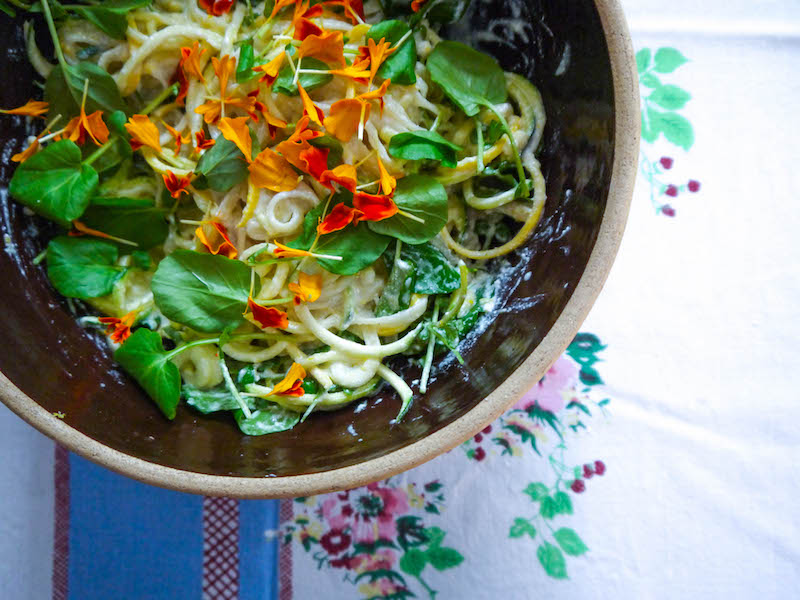 When I bought my friend Colu’s cookbook, Back Pocket Pasta, at one of her signing engagements, she gave me a wry smile and a little nudge in the ribs and said, “You can spiralize it.” She was half joking, as was I when I feigned offense at the implication that I would always eat vegetable noodles over the traditional wheat noodle. Because the thing is, I love pasta. My Dad’s spaghetti with meat sauce was a childhood favorite, as was a more sophisticated and complicated cold pasta dish of my Mom’s, involving bowtie pasta, pink peppercorns, artichoke hearts, hearts of palm and poached chicken. I love the versatility of pasta. The energy it gives you (wheat has protein, people, along with B Vitamins and essential minerals). I love the chew of it. The delicacy of thinly rolled pappardelle, the cling of ragu to a short fat noodle, and the treasure of a stuffed pasta like tortellini–the first bite like being let in on the most wonderful secret.
When I bought my friend Colu’s cookbook, Back Pocket Pasta, at one of her signing engagements, she gave me a wry smile and a little nudge in the ribs and said, “You can spiralize it.” She was half joking, as was I when I feigned offense at the implication that I would always eat vegetable noodles over the traditional wheat noodle. Because the thing is, I love pasta. My Dad’s spaghetti with meat sauce was a childhood favorite, as was a more sophisticated and complicated cold pasta dish of my Mom’s, involving bowtie pasta, pink peppercorns, artichoke hearts, hearts of palm and poached chicken. I love the versatility of pasta. The energy it gives you (wheat has protein, people, along with B Vitamins and essential minerals). I love the chew of it. The delicacy of thinly rolled pappardelle, the cling of ragu to a short fat noodle, and the treasure of a stuffed pasta like tortellini–the first bite like being let in on the most wonderful secret.
Many assume that I shun pasta, given my line of work. Pasta–along with bread and other foods made with wheat–has gotten a bad rap of late. It’s somehow been put in the “unhealthy” category with little regard for how it’s made, where it comes from, and whether or not the person eating it has any known sensitivity to digesting gluten or wheat. The verdict on the evils of gluten is still out, and opinions inside the nutrition world vary widely. My personal philosophy is as follows:
-If you feel fine, (or better than fine! good!) when you eat whole grain bread or pasta or couscous, then trust the signal from your body and eat it. Whole grains–including wheat and products made from whole wheat–contain lots of fiber, protein, and aforementioned vitamins and minerals. If you feel bad (digestive distress, sluggish, allergic, headache-y) after eating wheat and it’s products, then skip it. No expert will ever know your body better than you know your body. Trust yourself.
-As with most foods, all gluten is not created equal. Go for whole grain sources of bread, pasta and crackers. Avoid processed foods (duh) which tend to rely on heavily processed forms of wheat and gluten. Organic, semolina pastas imported from Italy or made with high quality flours in the states will likely feel better in your body than your standard refined white flour pasta. You can also keep an eye out for spelt and farro pastas which offer a heartier, nuttier flavor and higher protein, vitamin and mineral content per serving.
-If you notice that the vehicle for nearly every meal is wheat (toast, bread, pasta, cracker, etal), AND you don’t feel great, then switch it up! Try other grains like quinoa, millet, or brown rice. Eat a meal of protein, fat and vegetables and skip the grains altogether. Not because wheat or gluten are inherently bad but because our bodies want variety. Variety of food group, color and type of food is how we ensure that we are getting all the vitamins and nutrients we need.
-If you love pasta, EAT PASTA. If you love pasta and it doesn’t make you feel good, weigh that information without guilt. Food in, equals information out. Each time you eat, your body reports back to you. So, maybe pasta is a once-in-a-while thing, but when it is, enjoy it. Eat it without guilt, eyes open, mouth and pleasure receptors awake and present, and let yourself be nourished by the sheer enjoyment of eating a food that you love.
So, back to spiralizing. For those of you who haven’t seen packages of beets, zucchinni, butternut squash and carrots, transformed into long, pasta-like coils, these are the product of a spiralizer. A spiralizer is a kitchen contraption that will render any fruit or vegetable into pasta-like strands. You can change the setting to get a fettuccini, spaghetti or angel hair. If you don’t want to clutter your counter top with another kitchen tool, you can buy pre-spiralized vegetables at many natural grocers these days, or just julienne your veggies into long strands.
Because I like to maximize my vegetable intake whenever possible, and equally love a one-pan dish that meets all my nourishment needs, I often make my pasta dishes from half semolina or brown rice pasta and half zucchini “noodles”. That’s exactly what I did with Colu’s “Lemony Spaghetti” recipe. I chose fettuccini for both my semolina noodle and my zucchini noodle because I wanted more texture to my bite. I swapped her heavy cream for full fat organic yogurt, and used watercress which I had in my fridge in place of the called for arugula.
If you love pasta or know a pasta lover, I cannot recommend this book enough. It’s full of vibrant, tasty, and blessedly simple recipes that are easy to make from what’s on hand. The recipes are written in the personal, anecdotal, breezy way I love most in a cookbook because it is a reminder that recipes are merely a guideline–a place to start your own personal journey with experimentation in the kitchen. These aren’t hard and fast rules, but rather, tried and true directions with great results and an implicit invitation to improvise.
So, go forth and cook. Cook pasta. Cook zucchini noodles. Cook something else entirely. But, I urge you, make yourself a meal. Even if it’s for one. Even if it’s made from scraps of what’s in the fridge. Even if it’s a disaster. Make something with your own two hands. I promise you, it’s one of the best forms of nourishment you can give yourself, no matter what ends up on the plate. If you don’t know where to start, a hybrid lemony spaghetti might be just the place to begin.
Lemony Zucchini & Fettuccini Noodles
adapted from Colu Henry’s Lemony Spaghetti in Back Pocket Pasta
serves 4
2-3 lemons ( I used 1 very large Meyer & 1 very large regular lemon)
kosher salt
1/2 lb good quality dry fettuccini
2 medium zucchini/summer squash or 1 package zoodles
1 T olive oil
2 T unsalted butter
1/2 cup full fat organic plain yogurt or organic Greek yogurt
grated Parmesan (I only had a scant 2 T on hand but didn’t feel I needed more)
big handful watercress, arugula or other spicy green
lots of cracked black pepper
-Zest the lemons and set aside. Juice the lemons into a separate small bowl and set aside. You want about 2T of zest (I had much more and only used half), and 1/4-1/2 cup of juice.
-Spiralize your zucchini on the fettuccini setting and set aside.
-Bring a large pot of water to a rolling boil. Add 2 T kosher salt and return to a boil. Add the pasta and cook until al dente according to package directions.
-When the pasta is about 5 minutes from being al dente, heat the olive oil in a large skillet over medium heat. Add the butter and melt. Stir in the yogurt and reduce heat to low.
-Scoop the al dente pasta directly into the pan, add half of the lemon juice and half of the zest and stir like mad. Add 1/4 cup of the pasta water, the zoodles and the greens along with the Parmesan and keep stirring until the pasta and zoodles are well and evenly coated in sauce. Remove from heat and taste. Add more water or lemon juice to loosen the sauce as needed.
-Plate and serve immediately, garnishing with more lemon zest, more Parmesan as desired, edible flowers, chopped fresh herbs, and lots of cracked black pepper.
-As Colu points out, best to enjoy pasta with a glass of good wine. I recommend a clean, mineral-y white here.
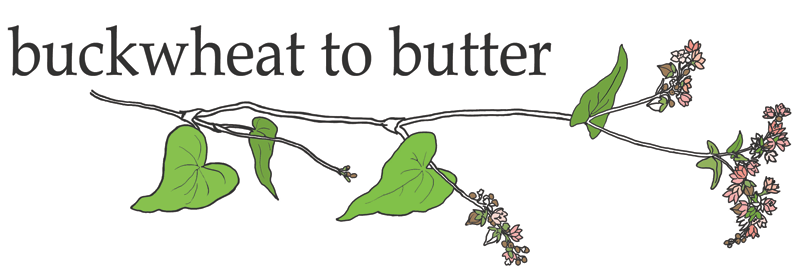
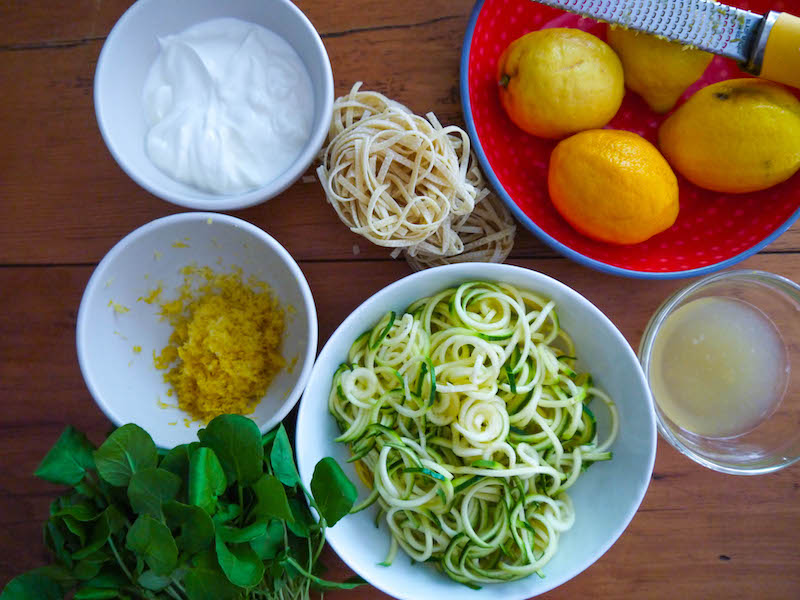
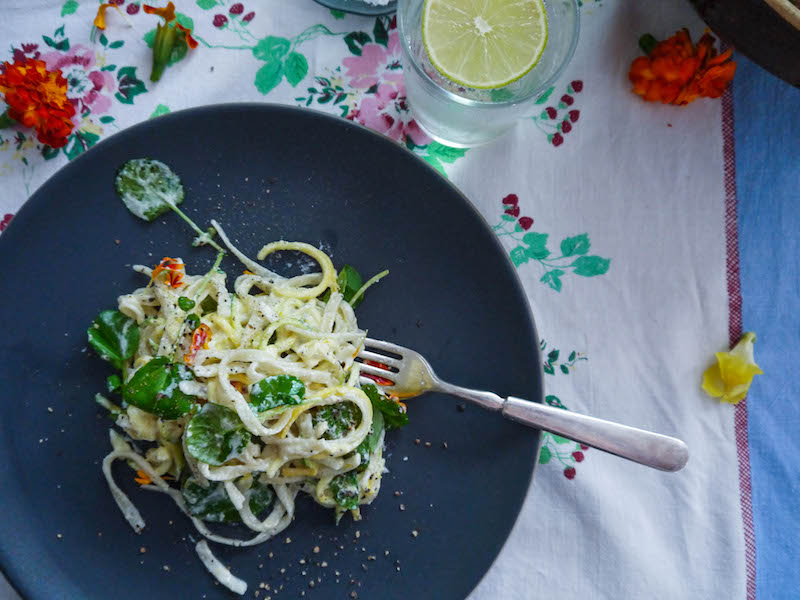
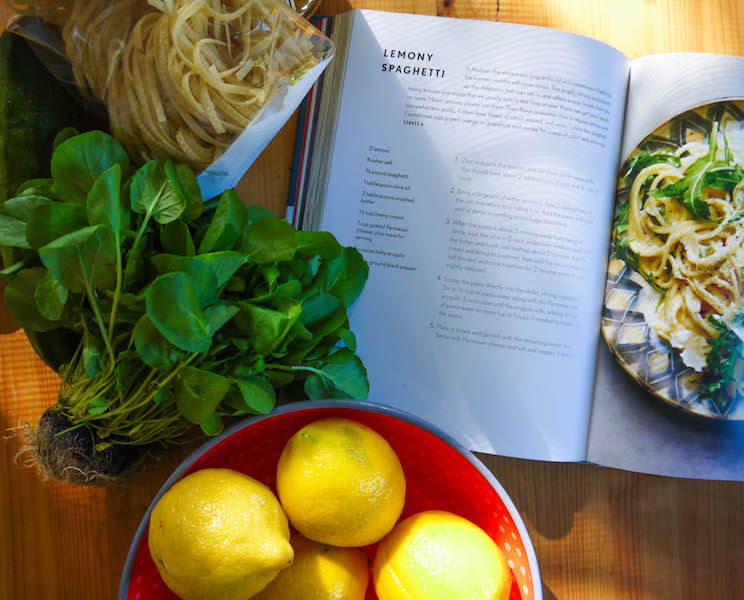
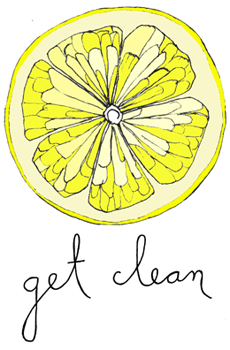
 Subscribe via RSS
Subscribe via RSS